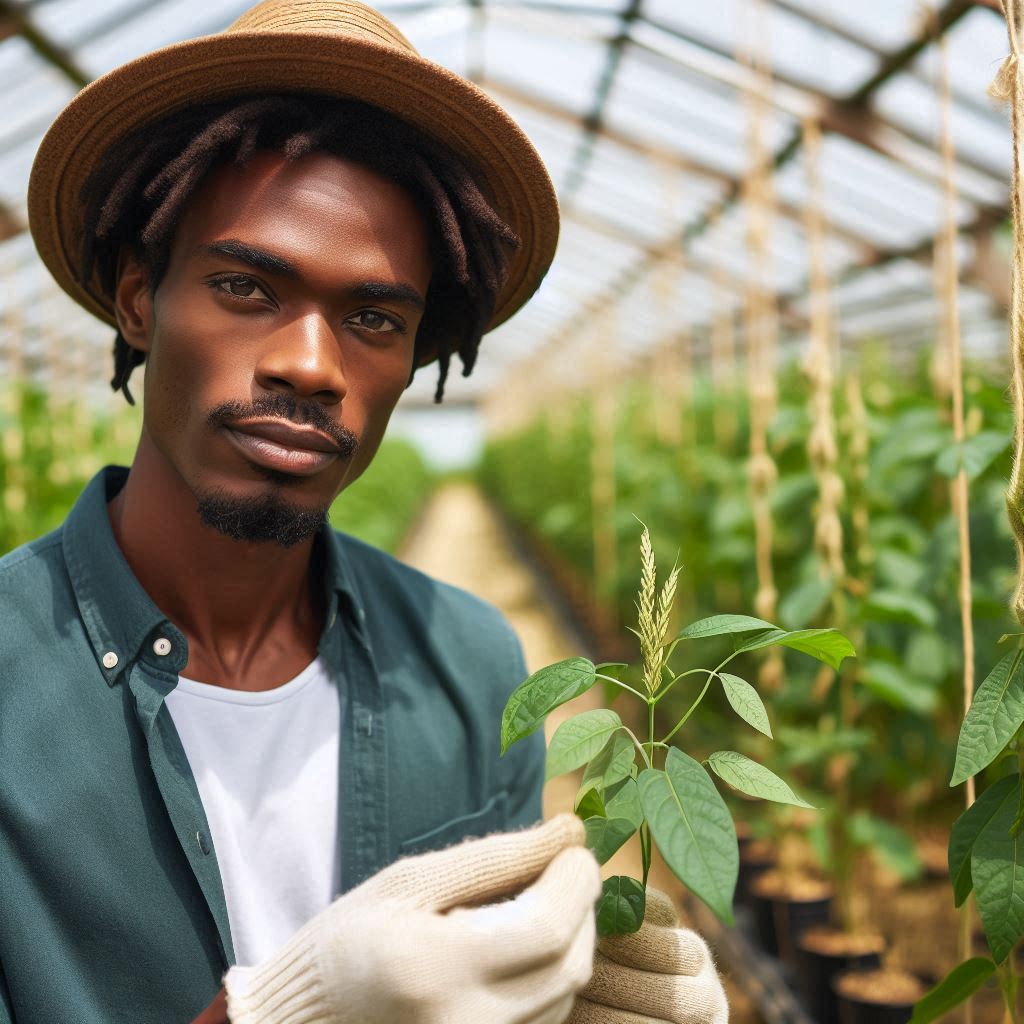Introduction
Plant breeding enhances crop yields, quality, and resilience, vital for food security and sustainable farming practices. Understanding it is crucial for beginners and experienced farmers alike.
It involves selecting and crossing plants with desirable traits to produce superior offspring. This method helps develop disease-resistant crops.
Improved crop varieties adapt to changing climates and increase agricultural productivity. Knowledge of plant breeding is vital for anyone in farming, research, or food production.
This guide breaks down the process into understandable steps. Key steps include selecting parent plants and evaluating offspring performance.
Understanding plant breeding is essential for making a positive impact on agriculture and food production.
By the end of this guide, beginners will have a solid foundation in plant breeding. It’s a fascinating and rewarding field, combining science, innovation, and practical applications.
Understanding the process is crucial for anyone aiming to improve food production and sustainability.
What is plant breeding
Plant breeding, a cornerstone of agriculture, encompasses deliberate interventions in plant genetics to enhance desired traits. This multidisciplinary field involves selecting and crossing plant varieties to develop offspring with improved characteristics.
Definition of Plant Breeding
Plant breeding is the science and art of modifying plant species through controlled breeding methods. It involves the selection of parental plants with desirable traits and the subsequent crossing of these plants to produce offspring with the desired characteristics.
Purpose of Plant Breeding
The primary goal of plant breeding is to improve crop performance and quality to meet the needs of farmers, consumers, and the environment. By developing new varieties with enhanced traits, plant breeders strive to:
- Increase crop yields to meet growing food demands.
- Enhance crop resistance to pests, diseases, and environmental stresses.
- Improve crop quality, including nutritional content, taste, and shelf life.
- Adapt crops to changing climatic conditions and agricultural practices.
- Enhance the sustainability and resilience of agricultural systems.
Examples of Successful Plant Breeding Initiatives
- Development of High-Yielding Rice Varieties: Plant breeders have successfully developed rice varieties with improved yield potential, disease resistance, and adaptability to diverse growing conditions.
These varieties have significantly contributed to increasing rice production and food security worldwide. - Breeding Maize with Enhanced Drought Tolerance: With climate change leading to more frequent droughts, plant breeders have focused on developing maize varieties resilient to water scarcity.
These drought-tolerant maize hybrids help farmers mitigate the impact of erratic rainfall patterns and ensure stable yields even under adverse conditions. - Creating Tomatoes with Improved Shelf Life: Plant breeders have developed tomato varieties with extended shelf life, reduced susceptibility to post-harvest diseases, and improved fruit quality.
These advancements have facilitated longer storage periods, reduced food waste, and enhanced marketability, benefiting both producers and consumers.
In summary, plant breeding is a dynamic field that plays a pivotal role in agricultural innovation and food security. Through continuous research, collaboration, and innovation, plant breeders strive to develop improved crop varieties that address the challenges facing modern agriculture.
Read: Scholarship and Funding Opportunities for Forestry Students in Nigeria
Basic principles of plant breeding
Understanding Genetic Diversity
Genetic diversity forms the cornerstone of successful plant breeding endeavors. It encompasses the variety of traits and characteristics present within a species, providing breeders with a rich pool of genetic material to work with.
This diversity allows breeders to select plants with desirable traits and combine them to develop improved varieties that exhibit enhanced characteristics such as disease resistance, drought tolerance, and higher yields.
Importance of Selecting Parent Plants for Breeding
The process of selecting parent plants is crucial as it determines the genetic makeup of the offspring. Breeders carefully evaluate individual plants based on their phenotypic traits and genetic background to ensure that desirable traits are passed on to the next generation.
By selecting parent plants with complementary traits, breeders can create offspring with a combination of desired characteristics, thereby accelerating the breeding process and achieving targeted outcomes more effectively.
Different Breeding Methods (Conventional vs Modern)
- Conventional Breeding: Conventional breeding methods rely on natural processes such as cross-pollination and hybridization to introduce genetic variation and create new plant varieties.
Breeders manually select and cross parent plants to produce offspring with desirable traits. While this approach has been widely practiced for centuries, it can be time-consuming and may not always yield predictable results. - Modern Techniques: Modern breeding techniques, including genetic engineering and molecular breeding, offer more precise and efficient methods for manipulating plant genomes.
Genetic engineering involves the direct manipulation of an organism’s DNA to introduce or modify specific traits.
Molecular breeding, on the other hand, utilizes advanced genomic tools and techniques to identify and select plants with desired genetic characteristics more rapidly and accurately.
By leveraging both conventional and modern breeding methods, plant breeders can accelerate the development of new crop varieties that meet the evolving needs of farmers, consumers, and the environment.
These techniques enable breeders to address pressing challenges such as climate change, pest and disease resistance, and food security more effectively, ultimately contributing to the sustainable advancement of agriculture.
Understanding these fundamental principles of plant breeding is essential for aspiring breeders and agricultural professionals alike.
By grasping the importance of genetic diversity, the significance of parent selection, and the diverse array of breeding methods available, individuals can embark on their journey in plant breeding with confidence, knowing that they are equipped with the knowledge and tools needed to make meaningful contributions to agricultural innovation and sustainability.
Read: Overview of Horticulture in Nigeria
Steps involved in the plant breeding process
Plant breeding is a complex process that involves several steps to create new and improved plant varieties. Understanding these steps is essential for beginners in the field of plant breeding.
Selection of Breeding Goals
Selecting the breeding goals is the first step in the plant breeding process. Breeders identify traits that they want to improve or develop in a new plant variety. These traits could include resistance to diseases, improved yield, or enhanced nutritional value.
During this stage, breeders also consider the environmental conditions in which the new variety will be grown. This helps in ensuring that the new plant variety will be well-suited to its intended growing conditions.
Crossbreeding or Hybridization
- Crossbreeding or hybridization is the process of mating two plants with desirable traits to create offspring with a combination of these traits.
- Breeders carefully select the parent plants based on their genetic makeup to ensure that the desired traits are passed on to the offspring.
- This step involves controlled pollination techniques to achieve the desired genetic combination in the offspring.
Testing and Selection of Offspring
- Once the offspring are produced through crossbreeding, they undergo rigorous testing to evaluate their performance.
- Breeders assess the offspring for the desired traits as well as other important characteristics such as disease resistance, yield potential, and overall plant health.
- Through systematic testing and analysis, breeders identify the offspring with the best combination of traits for further development.
Evaluation and Release of New Plant Varieties
- The final step in the plant breeding process involves the evaluation of the selected offspring in field trials.
- Breeders conduct extensive field trials to assess the performance of the new plant varieties under real-world growing conditions.
- After successful field trials and regulatory approval, the new plant varieties are released to farmers for commercial production.
Therefore, the plant breeding process requires careful planning, meticulous execution, and thorough evaluation at each step to develop new and improved plant varieties that meet the needs of farmers and consumers.
Read: Horticultural Tools and Equipment in Nigeria
Factors to consider in plant breeding
When engaging in plant breeding, several factors need to be taken into account to ensure successful outcomes. These factors play a crucial role in determining the overall success of the breeding process.
Environmental factors
One of the key factors to consider in plant breeding is the environment in which the plants will be grown.
Different plants thrive in different environments, so it is essential to select plants that are well-suited to the local climate and soil conditions. This will help ensure that the plants reach their full potential and produce high-quality crops.
- Consider soil type, pH level, and nutrient availability.
- Take into account temperature, humidity, and rainfall patterns.
- Evaluate the amount of sunlight the plants will receive.
Disease resistance
Disease resistance is another critical factor to consider in plant breeding. Selecting plants that are resistant to common diseases can help reduce the need for chemical pesticides and increase overall crop yield.
By breeding for disease resistance, farmers can ensure that their plants are better equipped to withstand potential threats and produce healthier crops.
- Identify common diseases in the region and select resistant plants.
- Use disease-resistant varieties as parents in breeding programs.
- Regularly monitor plants for signs of disease and take preventive measures.
Desired traits like yield, taste, and appearance
When breeding plants, it is essential to consider the desired traits that will make the plants more attractive to consumers. Traits such as high yield, excellent taste, and appealing appearance can significantly impact the marketability of the crops.
By selecting plants with these desired traits, breeders can create new varieties that meet consumer preferences and demand.
- Focus on improving yield to increase productivity and profitability.
- Enhance taste and flavor to meet consumer preferences
- Pay attention to appearance to make the plants visually appealing.
By carefully considering these factors in plant breeding, breeders can develop new varieties that are well-adapted to their environment, resistant to diseases, and possess desirable traits that appeal to consumers.
This comprehensive approach to plant breeding can lead to improved crop quality, increased yields, and ultimately, a more sustainable and successful agricultural industry.
Read: Hydroponics in Nigerian Horticulture

Challenges in plant breeding
When it comes to plant breeding, there are several challenges that breeders often face:
Time and resources required
Plant breeding is a time-consuming process that requires a significant amount of resources. Breeders need to invest time in selecting and crossing plants, evaluating the offspring, and conducting field trials to assess the performance of the new varieties.
Additionally, plant breeding often requires specialized equipment, facilities, and expertise, all of which come at a cost. This can be a challenge for smaller breeders or research institutions with limited budgets.
Ethical considerations
Plant breeding raises various ethical considerations, especially when it comes to newer techniques such as genetic modification. There are concerns about the environmental impact of genetically modified crops, as well as the potential effects on human health.
Breeders must carefully consider the ethical implications of their work, taking into account factors such as the potential benefits of new varieties, the possible risks they pose, and the need for transparency and public engagement.
Potential limitations of genetic modification
Genetic modification is a powerful tool in plant breeding, allowing breeders to introduce specific traits into crops. However, there are limitations to this approach, such as regulatory restrictions, public perception, and the potential for unforeseen consequences.
For example, some consumers are wary of genetically modified organisms (GMOs) due to concerns about environmental sustainability and food safety. This can create challenges for breeders looking to commercialize GM crops.
In review, while plant breeding offers numerous benefits, it also presents challenges that breeders must navigate.
By addressing issues such as time and resource constraints, ethical considerations, and the limitations of genetic modification, breeders can work towards developing new and improved crop varieties that meet the needs of a growing population.
Success stories in plant breeding
Examples of Plant Breeding Breakthroughs
Plant breeding has led to numerous breakthroughs that have significantly impacted agriculture and food security.
One remarkable example is the development of high-yielding, disease-resistant wheat varieties by Dr. Norman Borlaug, known as the “Father of the Green Revolution.”
His work in the mid-20th century transformed wheat production in countries like Mexico and India, preventing famine and boosting food supply.
In Nigeria, scientists developed improved maize varieties resistant to pests and diseases. The International Institute of Tropical Agriculture (IITA) introduced maize varieties like “TZE-Y Pop DT STR C4,” which withstand drought and Striga, a parasitic weed.
This breakthrough has greatly increased maize yields and resilience against environmental stressors, benefiting Nigerian farmers.
Another success story involves the development of hybrid rice varieties in Asia. Scientists created hybrid rice with higher yields and better resistance to pests and diseases.
These varieties have significantly boosted rice production, particularly in China and India, feeding millions more people and enhancing food security.
Impact of Plant Breeding on Food Security and Agriculture
Plant breeding plays a crucial role in enhancing food security and agricultural productivity. By developing crops with improved traits, breeders ensure a stable and sufficient food supply.
These improvements directly impact farmers’ livelihoods, increasing their income and resilience against environmental challenges.
One significant impact of plant breeding is increased yield of staple crops. Higher-yielding varieties ensure more food per unit area of land. This is vital in regions with limited arable land, meeting the growing food demand from increasing populations.
Plant breeding also improves the nutritional quality of crops. Biofortified crops, such as Vitamin A-rich sweet potatoes and iron-fortified beans, address malnutrition and health issues.
These nutrient-rich crops provide essential vitamins and minerals, improving public health outcomes, especially in developing countries.
Additionally, plant breeding contributes to environmental sustainability. By developing crops resistant to pests, diseases, and environmental stresses, breeders reduce the need for chemical inputs like pesticides and fertilizers.
This promotes sustainable farming practices, protecting ecosystems and reducing agriculture’s environmental footprint.
Plant breeding adapts agriculture to climate change. Breeders develop crop varieties that thrive in changing climatic conditions, ensuring stable food production despite temperature fluctuations, droughts, and floods.
This adaptability is crucial for maintaining food security amidst global climate challenges.
Ultimately, plant breeding success stories highlight its transformative impact on agriculture and food security. Breakthroughs in crop development have led to higher yields, improved nutrition, and greater environmental sustainability.
Continued investment and support in plant breeding are essential for advancing agricultural innovation and ensuring a resilient and secure food future.
Overall, plant breeding has significantly contributed to meeting global demands for food, feed, fiber, and fuel, promoting sustainable agricultural practices and mitigating climate change effects.
As technology advances, plant breeding will remain key to ensuring food security and supporting the growing population.
Transform Your Career with Expert Guidance
Get personalized mentorship consulting that’s tailored to your unique path. Our expert advice is actionable and exclusive.
Get StartedConclusion
Plant breeding enhances crop yields, quality, and resilience.
Understanding the basics of plant breeding is crucial for agricultural innovation.
By selecting and crossing plants with desirable traits, breeders develop crops that can resist diseases, pests, and environmental stresses.
This leads to higher yields and better-quality produce, directly benefiting farmers and consumers.
For beginners, exploring plant breeding opens numerous career opportunities in agriculture.
Knowledge of plant breeding helps in developing superior crop varieties that can adapt to changing climates and increase agricultural productivity.
This field is vital for food security and sustainable farming practices.
I encourage beginners to delve into plant breeding and its benefits.
Learning about this process can lead to a fulfilling career in agriculture or related fields.
By contributing to plant breeding, you can play a significant role in ensuring food security and advancing sustainable farming practices for a better future.




